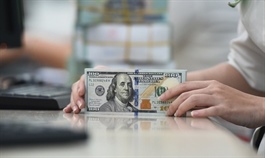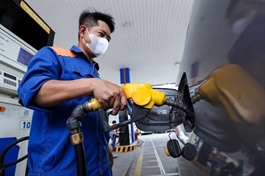UOB flags stronger VND and rising gold demand
UOB flags stronger VND and rising gold demand
With the VND expected to strengthen in 2026 and ASEAN economies maintaining steady growth, Heng Koon How, head of markets strategy at UOB, outlines key strategies for sustaining macroeconomic stability, highlights gold’s growing appeal across Asia, and examines how central banks are adapting to an increasingly complex global landscape.
|
How would you assess the economic growth outlook for ASEAN this year, especially as the US and Europe have just entered new monetary policy cycles?
The ASEAN outlook is still very positive. There will be short-term volatility because of the US-China trade uncertainty, but over the long term, all the long-term macroeconomic fundamentals are very positive.
For example, we have strong productivity and a very young, hard-working workforce. We have a strong savings rate among all the families across ASEAN, and most importantly, a large amount of foreign direct investment coming into the region, which is projected to rise to $370 billion by 2030. All these things added together will support strong, stable growth.
UOB forecasts about 4.5 per cent of GDP growth for ASEAN next year, and likely, if all goes well, it will be strong, stable growth. This is important because the rest of the world may be slowing down. The US is cutting interest rates. Europe has issues with Russia and Ukraine. China is slowing down as well. We see China's GDP going down from 4.9 per cent this year to 4.2 per cent next year. So, ASEAN is the only major economic block that we actually see strong, stable growth, very positive.
Despite the positive signal of ASEAN, the gold price rose by about 60 per cent on-year over the world, and 90 per cent in Vietnam. What risks may it cause?
Everybody loves gold right now. Central banks worldwide, from emerging markets to China, are buying gold to diversify away from US Treasuries. Retail investors across Vietnam, Singapore, and Australia are doing the same, seeking safety amid global trade uncertainties. From large institutions to small savers, there’s a growing move to shift from traditional assets and currencies into gold.
Our outlook for gold remains strongly positive. UOB has been bullish since last year, and we believe there’s good reason prices are holding above $4,000 per ounce, with potential to go even higher.
Gold also plays a crucial role in countries with weaker currencies, such as Vietnam and Indonesia, by helping preserve the value of savings and protect against local currency depreciation.
That said, investors should be cautious. Any asset that climbs 60 per cent in a year and moves in a straight line will face short-term volatility. While the long-term (two to three years) outlook is bright, expect fluctuations in the next few months because nothing rises forever without pause.
Could you provide the forecast for the gold price next year? And what uncertainties can impact the up and down movement of the price?
My honest answer is that my forecast for gold for the third quarter next year is $4,200 per ounce, and that was already traded yesterday morning. So, we will need to refresh our forecast at the end of this month for our monthly cycle.
As I said, the long-term view is positive. You ask what can change the view, what can go wrong? One simple reason: If suddenly we have inflation in the US or inflation in the rest of the world, and then the US Federal Reserve needs to hike interest rates instead of cutting. That will make the US dollar stronger again, which will be very negative for gold. So, we must be cautious of that because if the trade tariffs result in inflation in the US, then perhaps we will have volatility, and it will make it difficult for gold to go higher.
Finally, the most attractive and safe asset is always gold, which is a strong store of value, a safe haven for diversification.
What do you think about the Fed's upcoming move, raising or lowering the interest rate? And how does that impact the financial indices like gold, the US dollar, and other financial assets?
We expect the Fed to cut interest rates gradually and cautiously, 25 basis points at the end of October and another 25 in mid-December. These two cuts are largely priced in, as markets already anticipate a slowing US job market.
With the potential US government shutdown, federal layoffs could further weaken employment, reinforcing expectations for a total of 50 basis points in cuts this year.
Looking ahead to 2026, UOB projects two more cuts, though with less confidence. Much will depend on how the economy evolves, whether the job market softens further or inflation resurges, making next year’s outlook more uncertain.
Overall, the US Dollar Index has already fallen around 10 per cent this year. We expect continued, gradual dollar weakness as long as the Fed keeps cutting, potentially pushing the index down toward 97, 96, or even 95.
That said, the 'weak dollar' trade is already crowded. Everyone wants to buy gold or the euro, so short-term volatility is likely, especially heading into the year-end when liquidity tightens.
What should Vietnam's monetary and exchange rate policy priority be to maintain macroeconomic stability and support export growth?
Every central bank, including the State Bank of Vietnam (SBV), faces the same dilemma: on one hand, monetary policy needs to stay supportive to boost domestic growth and consumption; on the other, cutting rates too quickly risks weakening the currency. Striking the right balance between supporting the economy and maintaining currency stability is essential.
China offers a useful example. The People’s Bank of China (PBOC) has managed the Chinese yuan remarkably well this year. Around Liberation Day, many expected the currency to fall sharply, by 10 to 20 per cent, due to US tech tariffs. Instead, the yuan strengthened from 7.30 to 7.10 per dollar. The PBOC’s efforts to curb depreciation pressures have boosted domestic confidence: exporters aren’t worried about currency losses, and households can focus on spending without fear for their livelihoods.
China’s currency stability has also supported the broader ASEAN region, including Vietnam, helping regional currencies remain steadier. Every central bank can take a cue from this approach, and the SBV’s continued efforts to stabilise the Vietnamese VND will be key to sustaining domestic confidence and spending.
Given the current trend of a weaker US dollar, we expect the VND to appreciate modestly, possibly around 2 per cent over the next year, which would further reinforce market and consumer confidence.
- 16:51 20/10/2025


























